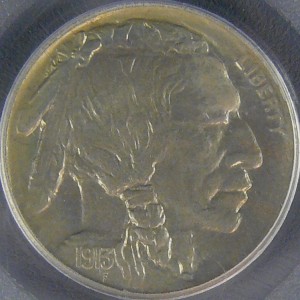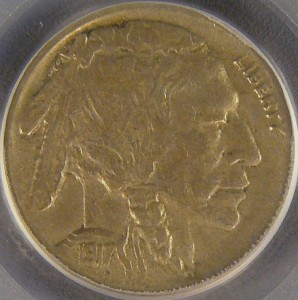As with all Abraded Die Varieties (ADVs), Two Feather varieties were created after some damage occurred to a die, typically from a die clash. If the clash occurred in the vicinity of the Indian’s small feather, the small feather may have been removed when a mint employee attempted to remove the evidence of the die clash.
What do clashed dies look like? What parts of the reverse die make an impression on the obverse die? The fields are the highest parts of the dies and consequently are the parts likely to collide hardest. The impressions left behind will be where the edges of the fields on one die intersect with the fields on the other die. To show what this looks like, I created a gray scale image of the obverse of a mint state buffalo nickel and the reverse of a matte proof buffalo nickel. This yields a “shiny” image of the obverse which is easy to distinguish from the “dull” image of the reverse. I then removed the fields (except for the areas near letters which was a bit too tedious for me to remove at this time) from the images. I aligned the images and then superimposed the obverse image on top of the reverse image. This is the result:
Take a while to look at this image. The white areas in this image are where fields clashed with fields. The edges of where these white areas meet the dull gray buffalo would be the likely clash marks on the obverse die resulting from a die clash.
For Two Feather ADVs, of particular note is the white area between the long feather and the neck and the edge created by part of the back and neck of the buffalo. This is the area of the die clash that, with a little overzealous polishing from a mint employee, could yield a Two Feather variety.
When abrading a die, it is likely a mint employee first used a very coarse abrading device. This would leave quite visible marks on the coin. These marks are visible on some Two Feather ADVs. In some cases (perhaps after checking what the coins looked like with a coarse abrasion) this might be followed by using a fine abrading device to remove the marks from the coarse abrasion. This very smooth surface is also present on some Two Feather ADVs.
Of course, die clashes are rather violent events. In addition to the clash marks, there could be other damage caused by the force of the dies striking each other. This damage likely would take the form of pock marks on the die (from debris and possibly sparks) or even die cracks from the extreme pressure of the collision. This suggests a wealth of possible clues to look for in addition to an abraded feather.
There are additional possibilities to keep in mind.
- Depending on the amount of damage or how careful they are being, a mint employee may not abrade away the entire feather.
- If the dies are not properly aligned, then clash marks might be present in slightly or significantly different areas.
- For any given pair of dies, there might be more than one clash and/or more than one attempt to abrade the clash marks.
- And for any year and mint mark, clashes could occur for multiple pairs of dies. In fact, for some years, there are two or even three die pairs that clashed, were abraded, and produced two feather varieties.
Thus, there can be Two Feather varieties with slightly varying appearances for us to look for and examine.



Leave a Reply
You must be logged in to post a comment.